Whether it is a parent or student looking to buy a French Horn for the first time, or an experienced player in the market to buy a new horn, the choices can be overwhelming if they are unsure of what to look for in an instrument. One may wonder why Horn players play different kinds of horns in specific ensembles, such as a brass band or marching band.
Throughout a horn player’s playing life and career, they often encounter many types of Horns, including Single, Double, Compensating Double, Triple horns, Vienna horns, Mellophones, Marching French Horns, alto/tenor horns, and Wagner tubas.
In this post, we’re going to take a look at all the different types of french horn and look at what the differences and similarities are. Let’s get started.
The Single Horns
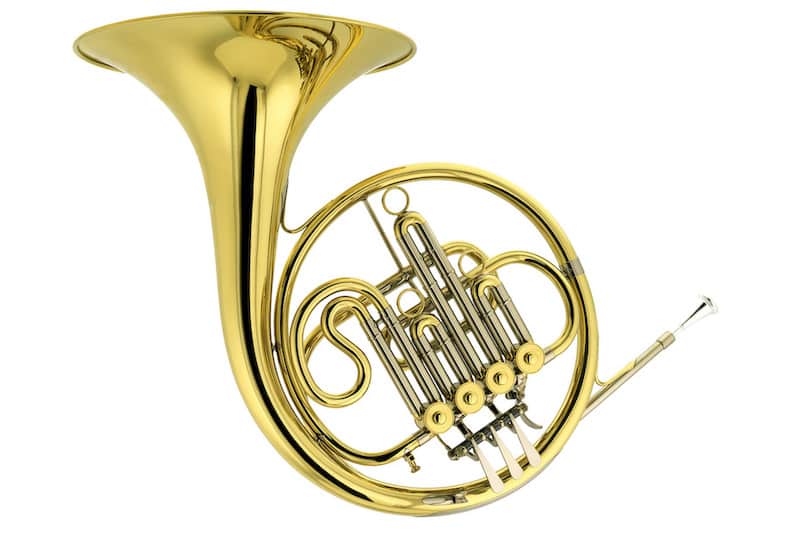
Often a popular choice of band directors and private music teachers for their young beginning students, the Single Horn in F is lighter weight, is less complicated in structure than the double and triple horns, and is the least expensive option to purchase.
These horns have the full classic sound desired in the mid to lower registers and can produce more notes than other types of single horns without using the valves.
The single horn in F contains three rotary valves with one lever each to activate the valves.
Although it is suitable for the young beginning hornist, the single horn poses some limitations for the more advanced players.
In the late 19th and early 20th centuries, orchestral hornists found the instrument lacking accuracy in the upper registers.
Therefore, the solution was to construct another single horn to be used for those registers.
Smaller and lighter in weight, the B flat horn was preferred by more experienced players on specific musical compositions due to its higher pitch.
This horn is equipped with four valves and is not as common today as the single horn in F.
The B flat’s fourth valve, called the stopping valve, has the slide length between the first and second valve slides.
However, the B flat horn also had its limitations as it had a lot less desirable tone in the middle to lower ranges.
Before the compact single horn, generations of horn players started their instrumental music journeys with the cornet because single F horns were too heavy and large for the average young child to hold.
These horn students switched to a single F horn in middle school when they had the size to hold the instrument.
Today, a recent invention provides another option for young horn players.
Light, compact, and easy to carry and play,the mini-compact B flat horn has an extra small wrap design and includes three rotary valves and levers.
Other types of single horns that are less common than their F, B flat, and compact relatives are the single F alto and the B flat alto/soprano descant horn.
The same length as a B flat trumpet and pitched an octave higher than a standard F horn, these horns are used in baroque horn concertos in which the music calls for a delicate sound in the upper register.
Jazz performers occasionally use f alto and the B flat alto/soprano descant horns.
The Double Horn
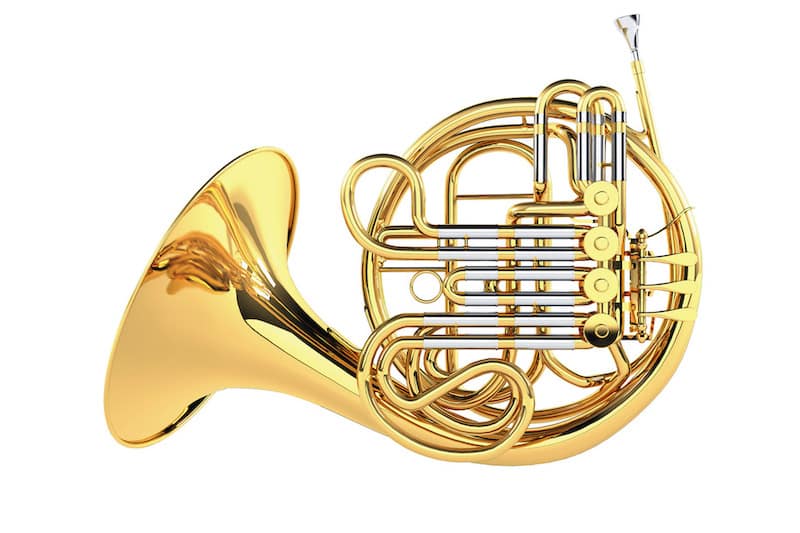
In 1897, German horn maker Fritz Kruspe presented a prototype to solve F and B flat single horns’ limitations.
This invention, called a Double Horn, is a commonly used type of horn of many intermediate, advanced and professional horn players today.
Combining both F and Bb horns’ tubing, this horn has slides on the top and smaller ones beneath them, enabling the musician to play the instrument in its full range with better accuracy.
With a fourth rotary valve, called the thumb valve or trigger by its lever, the airflow diverts from one set of slides, the F side, to another, the Bb side.
The thumb valve and slide, located above the first valve beside the thumb in some horns called a Kruspe wrap, while other double horns have the trigger valve located valve near the little finger is called a Geyer wrap.
Choosing a double horn with a Kruspe or Geyer wrap is often a player’s personal choice and preference.
Due to their higher prices and heavier weights, these horns are more suitable for intermediate to professional players.
The Compensating Double Horn
Rarely found in some parts of the world today, the Compensating Double Horn, described as halfway between a single and double horn, is lighter weight, has less tubing, and is less expensive to produce.
Played like a full double horn, this horn has a thumb valve that helps the airflow go through the extra tubing making the correct length to produce the desired F harmonic series.
While some hornists prefer playing a compensating double due to its lightweight, others find it difficult to tune because it does not offer the same level of secure tuning and natural harmonics that the full double horn provides.
The Double Descant Horn
The concept of a Double Descant Horn started with hornist and instrument designer Richard Merewether.
As a horn player specializing in the upper register, Merewether has worked on horn designs and the physics necessary for a model and instrument manufacturing success.
With his concepts, he approached horn maker Robert Paxman in the 1950s and started making the double descant horn pitched in F and F alto.
This horn enables the hornist to play the extreme upper registers with ease.
Soon after the F and F alto horn inception, Merewether and Paxman developed the B flat/F alto double descant horn.
Playing on the B flat side of the horn on most of its register, the player used the F alto side to play the instrument’s extremely high register.
The invention of the Double descant horns proved to be a success, and the inventors continued in their collaboration and developed over 50 models over the years.
Merewether and Paxman became a household name throughout the world.
The Triple Horn
Along with developing the double descant horn, Richard Merewether also developed the Triple Horn.
Heavier in weight and more expensive than the full double horn, the triple horn comes equipped with an extra thumb valve that facilitates the musician to play higher pitches via a third side of the instrument.
Even though the standard triple horn low F, Bb, and F-alto, some horns are equipped with a high F or Eb section to assist higher register.
Even though most professional horn players use double horns due to a triple horn’s high cost, some principal horn players in symphony orchestras play triple horns for added security in the upper registers required in their parts.
The Natural Horn
Honed and perfected by the 18th century by Dresden instrument maker Johann Werner from 1750 to 1755, The Natural Horn opened up composer’s and horn players’ playing possibilities.
Before the invention of the valved horn in the 19th century, this horn came with separate crooks inserted to fit the key of the music played.
With these crooks, the player’s embouchure, and a technique involving the right hand in the horn’s bell, playing orchestral music became easier for the hornist because of the newfound capability of doing chromatic scales.
Today, some hornists use the natural horn to play solos and ensembles that performs compositions from the 17th and 18th centuries.
For more information on older types check out our article on the history of the french horn here.
The Vienna Horn
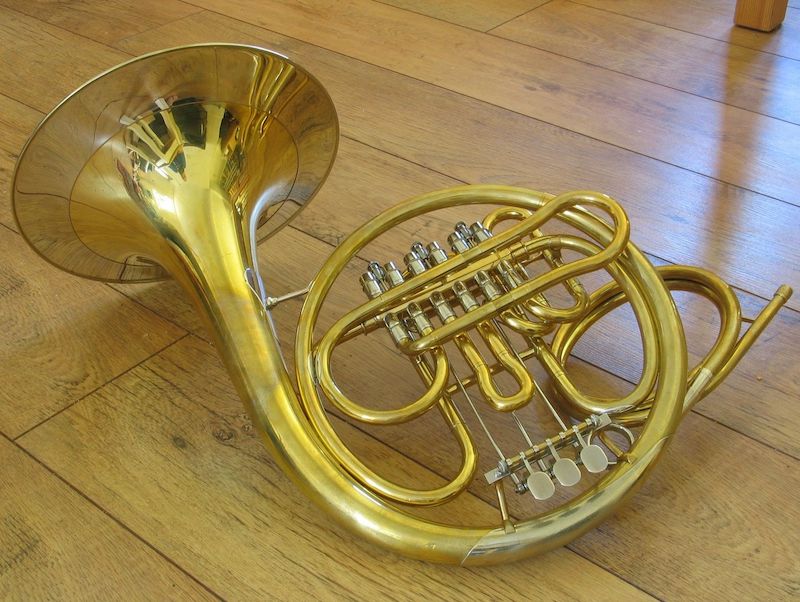
Generally found and used in Vienna, Austria today, the Vienna Horn is a single horn since they only have one slide per valve.
Unlike other horns, this horn features a unique set of double-cylinder valves known as pumpenvalves.
These valves, associated with the Viennese firm Uhlmann of the 1840s, are activated by levers like other horns’ rotary valves.
However, unlike rotary valves or standard piston valves, pumpenvalves have long push-rods that reach each lever key.
These valves redirect the air stream 90 degrees in one bend as it lessens the resistance felt by the hornist and contributes to its very smooth slurs.
Hornists who play on Vienna Horns use various hoops inserted into the instrument depending on the music played.
One loop, extended and placed between the mouthpiece and the horn’s body, puts the horn in the key of F.
Another, straight tube or smaller hoop for playing in the high registers that changes the instrument to the key of A or B flat.
Marching French Horns and Mellophones
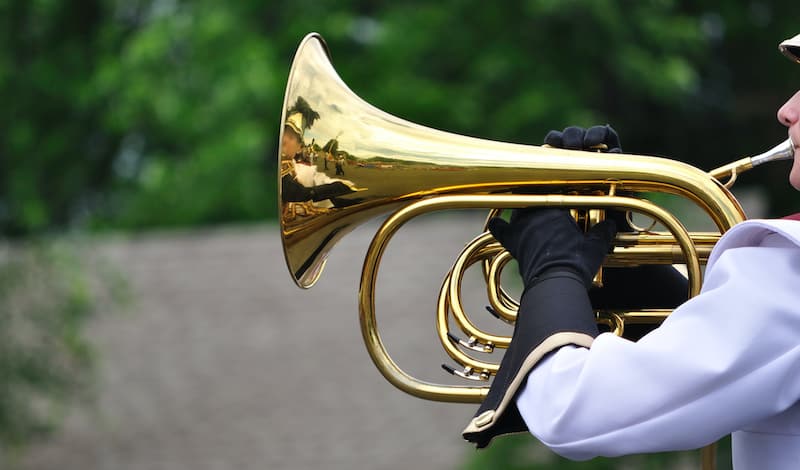
Even though hornists love playing their instruments, many find marching with it awkward while on the field with a marching band or corps.
Another issue with marching while playing the French Horn is the direction of the sound.
In comparison, the sound of other marching instruments project toward the front; the horn projects backward.
Marching French Horns and mellophones solve these problems.
Used in marching bands and drum and bugle corps since the 1950s, the marching mellophone, used in place of a concert horn, is a bell front instrument the projects the sound toward the front of the player.
The mellophone is pitched in the key of F and has half the tubing of a French Horn.
Like the mellophone in F, the marching French Horn is a bell front instrument used in marching bands and drum and bugle corps.
However, the marching French Horn is pitched in the key of B flat and contains more tubing.
Alto/Tenor Horns
Commonly played in British Style brass bands, the Alto/Tenor horn is an instrument pitched in the key of E flat and has a different name based on certain parts of the world.
The American English term of the instrument is called the alto horn, British English, the tenor horn and the German name, Althorn.
With its mini tuba-like appearance and piston valves, the alto/tenor horn is considered one of the brass band’s mellow instruments.
It provides alto and tenor voices while serving as a critical component of the ensemble.
The Wagner Tuba
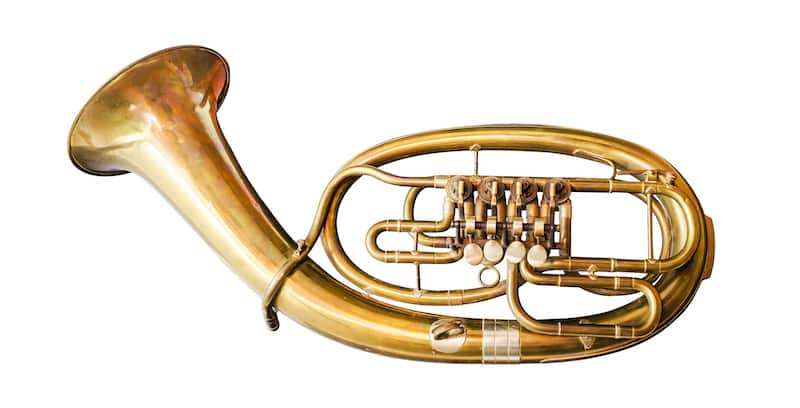
Conceived by Richard Wagner (1813-1883) while writing his composition Das Rheingold in 1853, the Wagner Tuba is a rare orchestral instrument.
This instrument, like the French Horn, has rotary valves and is played with the left hand.
The Wagner Tuba comes typically in a tenor pitched in B flat or a bass one in F.
Recently, manufacturers combined the two instruments into a double Wagner tuba that can easily be configured in either B♭ or F.
Conclusion: Which Type Should you Learn?
We hope that helps shed a bit of light on the types of horn and what the differences are between them all.
It can seem confusing at first but once you try them out in person you’ll soon get to know what’s what.
When choosing which French Horn to play, a musician considers a few things:
The level of the player: Is the player a beginning or advanced student, a professional hornist?
Single horns are appropriate for beginning students, while double horns are the best choice for more advanced and experienced players.
The Ensemble: French Horns, whether single, double, or triple, are appropriate for orchestras, chamber/wind ensembles, and concert bands.
Mellophones are for marching bands and Drum and Bugle Corps, while alto/tenor horns are for British Style brass bands.
The Music Played: Musical compositions such as Anton Bruckner’s Seventh and Ninth Symphonies include the use of Wagner Tubas and French Horns.
Some orchestras add extra horn players to play Wagner tubas.

